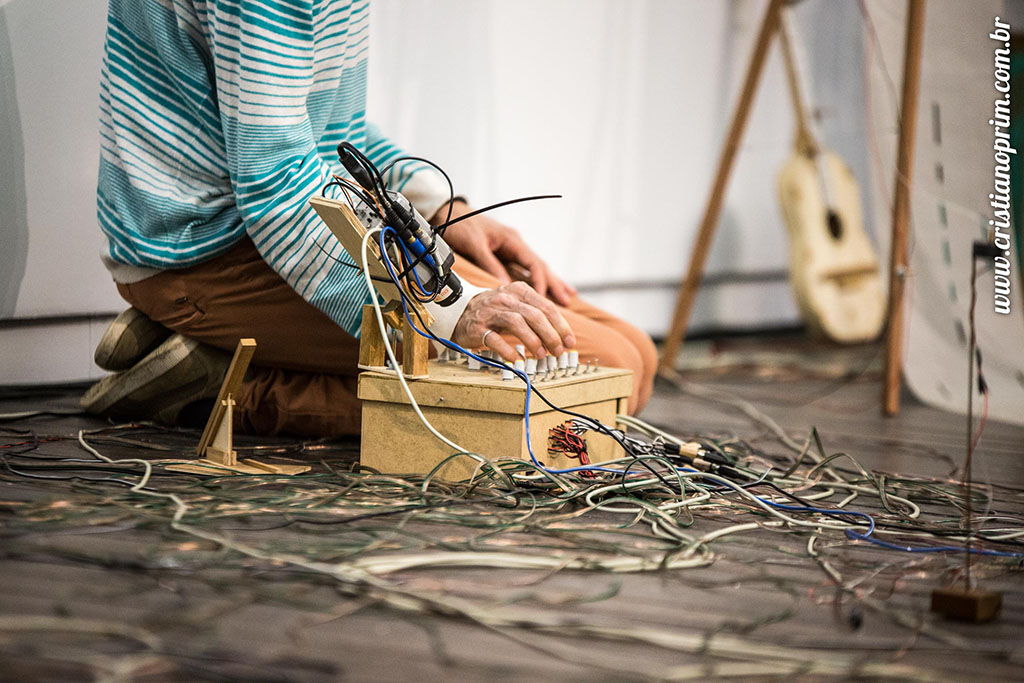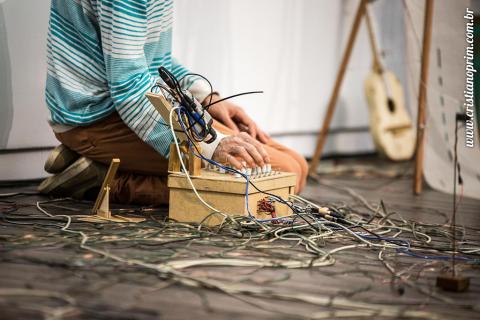
audiovisual machine, fictional machine, celibate machine, scenic
machine, performative machine, unproductive machine,
conductor machine, music score machine, sound machine,
machine that does not exist in series, musical machine,
imaginary machine, combined machine, sculptural machine,
metaphoric machine, collaborative machine, noisy machine,
infinite machine.
Under the skylight of the Museu de Arte de Santa Catarina, two metal hard cases of roughly 1m2 were delivered by the couriers. Inside the cases were some cardboard boxes containing wooden instruments, wires, electronic equipment, welding tools and other bits and bobs. While one artist unpacked the items listed above and restored the machines that had been damaged in transit, the others organized the wiring and assembled the components of the Orchestra Machine. Finally unpacked and restored, the machines began to occupy the space under the skylight. They were positioned so as to enable them to speak to each other and to the public, forming a kind of semicircle. The wires, beforehand scattered around the floor, were hooked up to a box that converts the electrical signals emitted by the pianolas (conductor machines) into MIDI (Musical Interface Digital Instruments) signals and another box that amplifies these pulses so that they are powerful enough to move the electric motors.
Fundamental to the operation of the Orchestra Machine, these electric motors drive elements of the sculptures, such as the propellers made of Heineken cans and straws. These acoustic sculptures are carefully connected to each other by miniscule metal bars, forming a web that prevents them from falling when triggered. Another element that is engaged is a piece of nylon that is spun to perform the function of a bow that plays the string of an unusual single-stringed instrument made out of a loaf tin and producing a sharp, metallic noise. Other objects, like the “radinha” and the surveillance cameras which film and broadcast the orchestra in real time via small monitors are also activated by the conductor machines. These, in turn, are equipped with sheet music operated by voids: each note is marked with a hole, or a sequence of holes, on graph paper. These holes close electrical circuits emitting pulses, the duration of which depends on their size and on the speed of the motor that transports the paper. In other words, the three conductor machines are responsible for driving all the others.
This was the eighth time that Roberto Freitas, O Grivo and Marcelo Comparini had assembled this fictional performance-sound installation. The interesting thing about it is how the subject is displaced before an orchestra that produces a musical effect with no music. Adding silence to the scores, the resonations made by these machines are the noises of the world. The machines become temporary receptacles of the surrounding space. Whatever the scale of the sounds produced by the Orchestra Machine may be, there is always a metaphysical dimension. The silence that is transmitted by the machines leads precisely to a two-word paradox: silent sound; where silence should be understood as the possibility to listen to the surroundings. The Orchestra Machine, therefore, enters an area of profound indiscernibility; there is a fascination for the unknown, for raw listening, for the micro-variations of sound, for the tones and micro-tones, for fictions stacked upon each other, for disorder.
In a way this installation is composed of objects that do not obey an imperative to be stripped down, as they have been displaced from their functions. And this stripping down, for sociologist Jean Baudrillard, characterizes the attribution of a function to the object, that is, its neutralization by the function. That is why faithfully recreating a given work (score) or, even, dominating all the technical resources of the instruments are irrelevant issues as far as the Orchestra Machine is concerned. Not least because the instruments’ resources are rudimentary; constantly reinvented and adapted by the artists, who are responsible for perceiving and organizing the internal dynamic of the orchestra, intervening and transforming its acoustic landscape, configuration and setting.
In the absence of the artists, the Orchestra Machine is controlled by a timer. This takes on the responsibility for the levare, or upbeat, the conductor's upward stroke to initiate the first movement. That is why the Orchestra Machine is not only an orchestra of machines, but an orchestra of machines which orchestrate each other. As an assembly of pieces [sculptures] which operate together to execute an audiovisual work, the Orchestra Machine transforms one kind of mechanical movement into signals systematically employed in a performative, sound and unproductive action. It is not a theatre of gestures, but rather an arrangement of everyday objects taken out of their usual functions, of fragmented movements, orchestrated by the conductor machines. It is perhaps necessary to remark that the mechanistic euphoria fueled by the Orchestra Machine is melancholic, with a particular kind of anguish which emerges from undecipherable, noisy and irregular sounds.
The futility of the Orchestra Machine provokes a rupture in the rhythm of everyday life, interrogating us about what we do in a machine-like way, pointlessly. In a way, it is an imaginary machine, but one that possesses a real place in time and space. And it challenges the idea of present, past and future, asserting the coexistence of matter and antimatter. From the perspective of Pataphysics, "the science of imaginary solutions which symbolically attributes the properties of objects, described by their virtuality, to their lineaments," the Orchestra Machine seeks a truth in the immediate, interposes itself between the world and the opacity of the subject, creating problems for the invention of solutions.
The meeting between Roberto Freitas, O Grivo and Marcelo Comparini came about through a combination of circumstances, both personal and professional. Professional because Roberto and Marcelo shared a studio for several years in São Paulo. And personal because the four artists share common art production processes and references. Music, movement, electronics and the invention of sound machines, for example, are fundamental elements to their art. For Roberto Freitas, the Orchestra Machine is fictional and “is based on games of pulleys, transmission belts, monitors and camera that, when connected, impiously spend energy to achieve almost no work. What we are dealing with here is an unproductive and unfertile machine, a kind of celibate machine that, like Marcel Duchamp’s Large Glass (La mariée mise à nu par ses célibataires, même), transforms erotic love into the pulsation of death.”
Luigi Russolo, an Italian artist who, inspired by the industrial revolution, published the manifesto “The Art of Noises” in 1913, had a particularly good understanding of fictional or futuristic machines. His interest in the noises of machines, of the motors, of the crowds, led him to invent the “intonarumori”, mechanical instruments capable of translating acoustic realities that were far from usual for string instruments. He believed that noise was born with the invention of the machines and the consequence was its triumph over man's sensibility. For Russolo, “we need to break out of this narrow circle of pure sounds and conquer the infinite variety of ‘noise-sounds’”. Although this manifesto was written over one hundred years ago, it remains relevant; indeed, increasingly more so. With rare exceptions, orchestras in general remain reduced to four or five classes of instrument, which differ in the timbre of their sound: strings, picked strings, brass, woodwind and percussion.
In the Orchestra Machine, the variety of noises is infinite. And we could consider that his hypothesis was correct. To paraphrase Russolo, while in his time there were perhaps a thousand different machines, we might distinguish a thousand different noises; today, with the abundance of new machines, we might distinguish ten, twenty or thirty million different noises, "not to merely imitate them, but to combine them according to our fancy." All the machines that form this installation were built manually by the artists, who worked as carpenters, electricians, scientists, physicians, designers and mathematicians. This means that the noises produced by the machines are unique and do not fulfill the role of representation, but rather presentation of other possible realities, of other spaces of imagination and fantasy. These are not precise machines but, in the words of Roberto Freitas, the materialization of thoughts resulting from discussions between the artists. For them, to make the objects is a way of talking about the very nature of what they are doing. Orchestra Machine emerges, therefore, from the meeting between bodies and machines, between silence and noises, between programming and improvisation, between technology and precariousness, between circuits and fantasies, discharge and contention.


